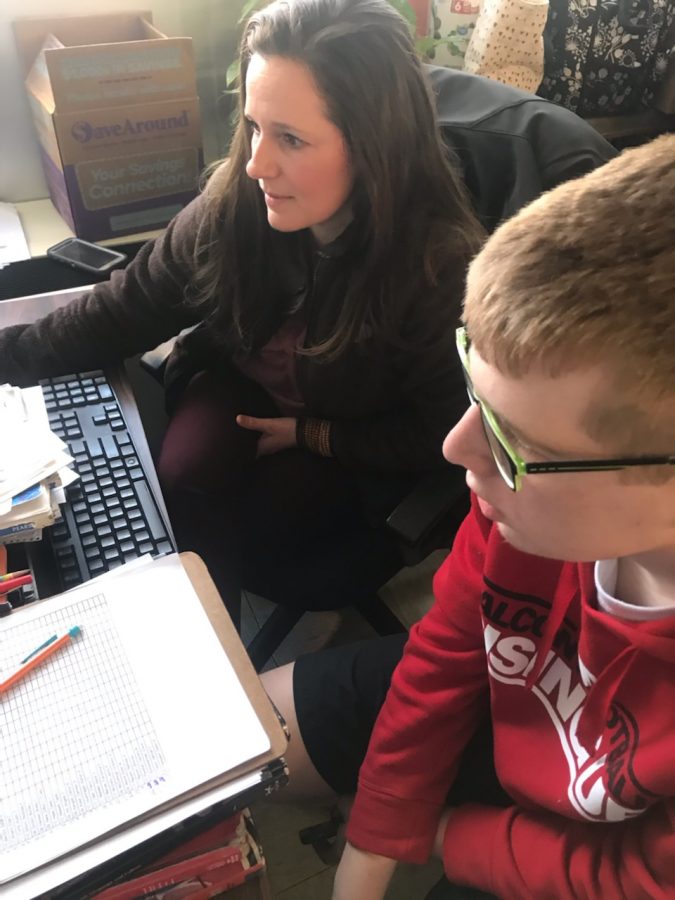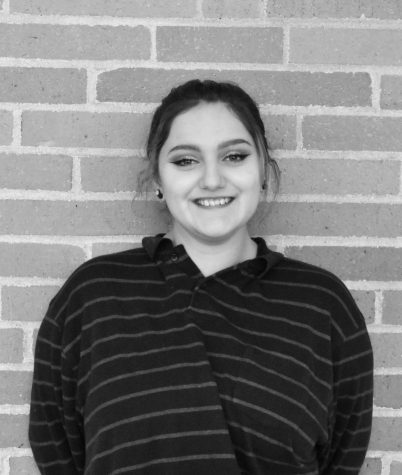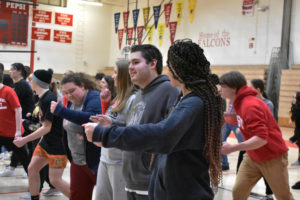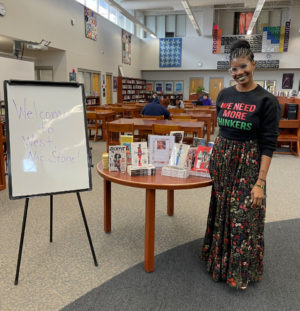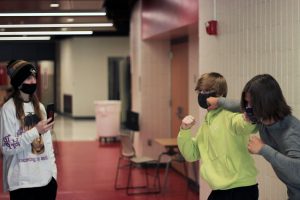Thoughts behind SEL (social and emotional learning)
Spanish teacher Stephanie Hansen helps her advisory student sophomore Caleb Heskett sign up for Falcon Flex. Hansen allows her advisory students to sit in the back chairs by her desk, allowing conversations to flow throughout the class.
February 11, 2020
You walk into school on a Monday morning to a room of familiar faces. You sit down, pull out your chromebook, and sign up for flex. This is the usual, however, what about the occasional lessons and slideshows? Some teachers try to connect and open discussions with their students, some get through them because they have to, and others, simply don’t do them at all.
The state board of education requires schools to teach SEL, which stands for social and emotional learning. SEL touches on five main subjects, self awareness, social awareness, self management, relationship skills, responsible decision making. Lessons are designed by teachers, administration, counselors, and social workers throughout the district and the information is brought back to each building. English teacher Angela Staber thinks the advisory lessons are important for students, and understands how hard it can be to help them.
“Today, teenagers have so much going on that as adults we have experience but we just haven’t experienced it the way students do now,” Staber said. “Adults didn’t grow up with social media, and we have no idea how when teens see a post, immediately their emotions are going crazy up and down all the time.”
Staber says that the social and emotional lessons help her connect to her advisory students. Staber thinks being able to identify different emotions is important, and that’s how one can help people.
“By saying that I’m so angry, well angry can be anything. I get angry about small things,” Staber said. “But if a student is more specific in saying that they feel frustrated or they feel disappointed in themselves because they didn’t do something, then we can really address what the underlying issue is.”
However, it wasn’t always the easiest for Staber to connect and have open discussions with her students. Junior Hayley Carriker, a student in Staber’s advisory, says that maturity has a lot to do with how well the lessons go over.
“Over the past three years of being a freshman to a junior we’ve changed a lot and the comfort level of Mrs. Staber’s class changed a lot. As freshmen we had a similar lesson and we didn’t really have much of a discussion and when there ever was discussion it never lasted longer than 30 seconds,” Carriker said. “But now as juniors we had a good six minute discussion, we all had our different views on it, and pretty much everybody in the class said something. We went in depth about it.”
Freshman Julian Charley disagrees with the idea of maturity playing into how lessons affect students, and believes it depends more on interest.
“I think the lessons could help some kids, but a lot of them just don’t pay attention,” Charley said. “ I don’t think it’s based off of age or maturity, I just genuinely think kids don’t care.”
Although some teachers see the lessons as an opportunity to connect and help their students, other teachers don’t do them at all. Sophomore Grace Echols says that she has no idea that lessons were being taught because her advisory teacher had never gone through them.
Spanish teacher Stephanie Hansen thinks some teachers just don’t know how to help their students.
“There definitely are some teachers who I get a vibe from where they’re here for the paycheck, they’re here for their certain amount of time and that’s it,” Hansen said. “Maybe they just don’t know how to help kids, not that they don’t want to, but that they don’t know how.”
Hansen believes that not everything put in lessons are useful for her students. However, she still wants her students to know why the lessons are being taught.
“I feel like the lessons are beneficial but not quite to the extent that teenagers need,” Hansen said. “I pull out the things I think my students are definitely gonna need help or guidance with and I kind of focus on those. Those are the things I feel that are very important and will affect students.”
Although she sees them as beneficial, Hansen is unsure of how effective the advisory lessons are to teenagers.
“Students have been told to not bully or harass people since middle school, but people still do it,” Hansen said. “I feel like to an extent these lessons make people aware of the problems going on, but not necessarily to the point where they would act upon it.”
Social worker Jenn O’Hare agrees that the lessons are only a start for teenage development. Just like any other core classes, you can’t learn social and emotional learning in just one lesson.
“The district’s goal, my goal, is that social and emotional lessons need to be integrated into everything else we do,” O’Hare said. “There all adults who feel like kids should already know this stuff, why do we need to go over it but the reality is, not everyone’s upbringing is the same.”
O’Hare wants kids to have a healthy mental state before anything else.
“School is important, but it’s not the most important thing in the world. The most important thing is that kids are safe, happy, and healthy and if they’re safe, happy and healthy, they learn,” O’Hare said. “Kids come to school not only to learn about math, science, and social studies, but they learn how to be a responsible and caring individual who can contribute to their life and others.”


